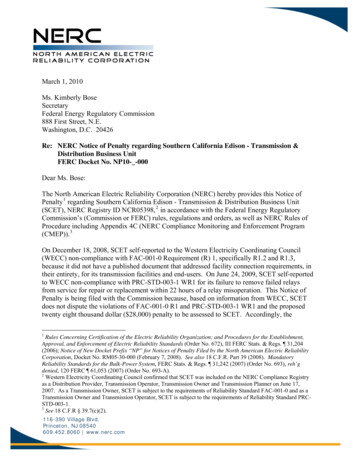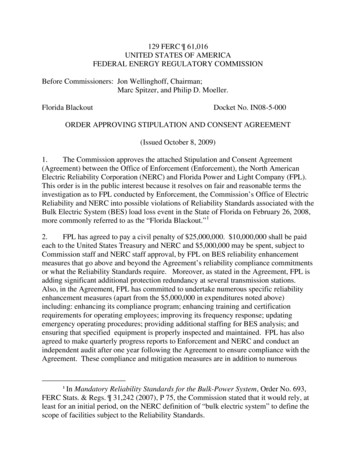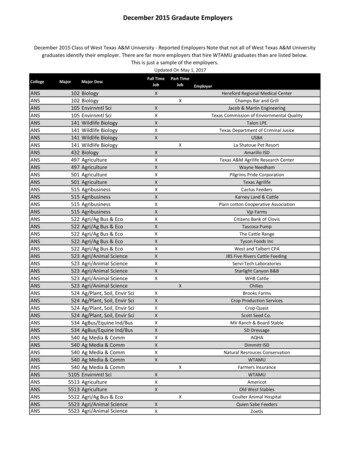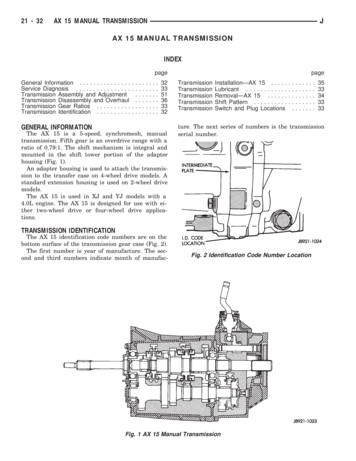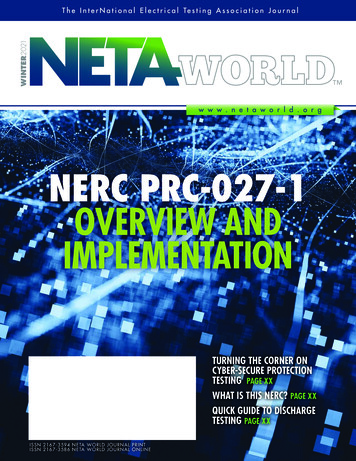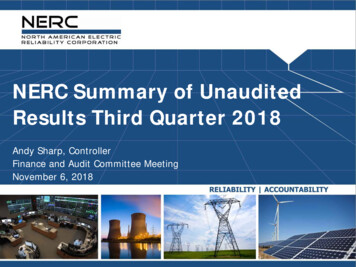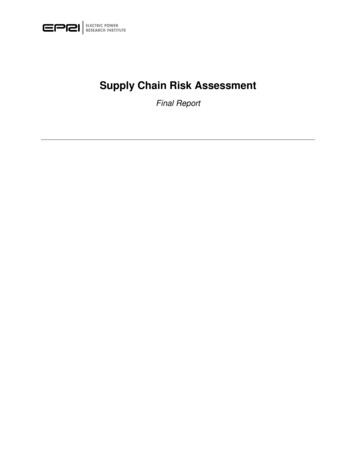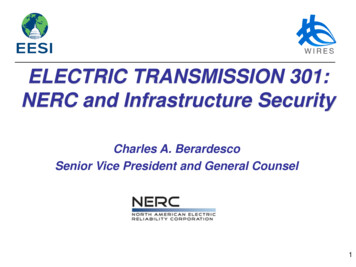
Transcription
ELECTRIC TRANSMISSION 301:NERC and Infrastructure SecurityCharles A. BerardescoSenior Vice President and General Counsel1
Agenda NERC OverviewStandardsCompliance Monitoring and Enforcement ProgramCritical Infrastructure ProtectionReliability Assessment and Performance AnalysisReliability in CanadaNERC Resource and Contact Information2
NERC Overview3
History of NERC Evolution from voluntary, industry-sponsoredorganization to certified Electric ReliabilityOrganization (ERO) Certified as ERO pursuant to section 215 of theFederal Power Act Subject to oversight by FERC and Canadian federaland provincial authorities Delegation agreements with Regional Entities (REs) Reliability Standards became mandatory andenforceable on June 18, 20074
Role of the Regions NERC works with eight (8) REs Authority delegated pursuant toSection 215(e)(4) of the Act(separate delegation in U.S. andCanada) REs enforce Reliability Standardswithin their geographicboundaries May develop Regional ReliabilityStandards and Regional Variances Must comply with the applicableprovisions of NERC’s Rules ofProcedure and ReliabilityStandards5
NERC’s Statutory Program Areas Reliability StandardsCompliance Monitoring and Enforcement ProgramOrganization registration and certificationReliability Assessment and Performance AnalysisTraining, Education and CertificationSituation AwarenessInfrastructure Security6
NERC Perspective on KeyPotential Risks Changing Resource Mix Coal to natural gas Effect of renewables Effect of distributed generation Extreme Physical Events GMD Storms Cold Weather Preparedness Cyber and Physical Security Responding to nation-state threats7
Standards8
Stakeholder Accountability9
Standards Committee Prioritizing standards development activities Reviews actions to ensure the standards developmentprocess is followed Reviews and authorizes Standard AuthorizationRequests (SARs) Manages progress of SARs and standardsdevelopment efforts Reviews and authorizes drafting new or revisedstandards and their supporting documents Makes appointments to drafting teams10
Stakeholder Consensus Process11
Major New Standards Physical Security Filed with FERC, awaiting approval Requires applicable entities to assess major risk and developprotection plans CIP Version 5 Standards Only national and enforceable cyber-security standards Working actively with industry to transition to newstandards Response to FERC directives contained in order approvingVersion 512
Compliance Monitoring and EnforcementProgram (CMEP)13
CMEP Overview Focus on improving bulk power system reliability Prompt reporting Protects confidentiality of involved parties Regional implementation REs perform compliance monitoring of users, owners andoperators on behalf of NERC NERC oversight role Active oversight Review of regional implementation14
CMEP Overview (Cont’d) NERC monitors, assesses and enforces compliance CMEP identifies eight (8) monitoring methods: Self-ReportSelf-CertificationPeriodic Data SubmittalException ReportingComplaintsCompliance InvestigationsCompliance AuditsSpot Checks Over 1,900 entities are subject to over 100 Standards15
Reliability Assurance Initiative Development and enhancement of risk-basedcompliance and enforcement approaches Activities include: The completion of an ERO-wide Compliance Auditor Manualand Handbook ERO-wide consistent methodologies for risk assessment andevaluation of management controls Improvements to self-reporting and streamlinedenforcement process, known as Find, Fix, Track and Report Pilots to streamline enforcement and focus resources onthose areas that pose a greater risk to reliability and securityof the bulk power system16
Aggregation ProgramPurpose:Allows applicable registered entities to self-assess issues,identify risk, and mitigate issues posing a minimal risk toreliability Participants will maintain a record of instances ofnoncompliance with specified Standards Minimal risk issues only Tracking format by spreadsheet Spreadsheet provided to Regional Entities after six months17
Enforcement DiscretionPurpose:to identify minimal risk issues which would be recorded andmitigated without triggering an enforcement action NERC and the Regional Entities will monitor and logissues tracked for enforcement discretion treatmentto refine discretion criteria (including issues regardingrisk) and monitor trends Only minimal risk issues at this time18
End-State RAI ProcessesMaturity ContinuumMature controls /Risk assessmentControls not providedEligible for adjustmentin scope, monitoringand related testingMay require increasedscope, monitoring ortestingMay be eligible foraggregation/loggingNot eligible foraggregation/loggingPresumption ofdiscretionNo presumption ofdiscretion19
NERC Critical Infrastructure ProtectionDepartment Priorities20
CIP Department Priorities Critical Infrastructure Protection (CIP) Standards CIP v3 to v Transitioning Electricity Sector Information Sharing and Analysis Center (ESISAC) ES-ISAC Capability Enhancements Cyber Risk Preparedness Assessments White House Electricity Subsector Cybersecurity Capability Maturity Model Coordination of efforts with reorganized Electric Sub-SectorCoordinating Council Outreach and Awareness Activities Grid Security Conference Grid Security Exercise21
Reliability Assessment and PerformanceAnalysis22
Reliability Assessment andPerformance Analysis (RAPA) Assess, measure, and investigate historic trends andfuture projections to ensure BPS reliability. Identify the trends Analyze and benchmark the trends Identify solutions and assess needs for BPS reliabilityimprovement Develop solutions to those problems and needs23
Reliability and AdequacyAssessments Three annual independent reliability assessments prepared,pursuant to authority in FPA 215(g), whereby NERC is requiredto conduct periodic assessments of the reliability and adequacyof the bulk-power system in North America Long-Term Reliability Assessmento 10-year outlook Winter Reliability Assessmento Issued in the late fall, which reports on the reliability outlook for thecoming winter season Summer Reliability Assessmento Issued in the spring, which reports on the reliability outlook for thecoming summer season24
NERC Reliability Assessments Peak demand forecastsResource adequacyTransmission adequacyKey issues and emergingtrends impacting reliability Technical challenges Evolving market practices Potential legislation/regulation Regional self-assessment Ad-hoc special assessments25
Periodic Special ReliabilityAssessments Accommodating High-Levels of Variable GenerationImpacts of Environmental RegulationsSmart Grid Reliability ConsiderationsReliability Impacts of Climate Change InitiativesEffects of Geomagnetic Disturbances on the BPSNatural Gas and Electric Power Dependencies26
Performance Analysis of BPS Identify and track key reliability indicators as ameans of benchmarking reliability performance andmeasuring reliability improvements Include assessing available metrics, developingguidelines for acceptable metrics Maintaining reliability performance indicators Developing appropriate reliability performancebenchmarks27
Reliability Risk Analysis andControl Works with Events Analysis, Reliability Assessments,and Performance Analysis to identify key reliabilityrisks Supports the Reliability Issues Steering Committee(RISC) Administers RISC processes for cataloging, analyzing,and controlling reliability risk28
Reliability in Canada29
Electric Reliability in Canada Constitutional authorities Ensures no one dominant/authority perspective History of the industryStructure and characteristicsA long history of reliabilityCommitment to, and expectations of, an internationalERO Ongoing cross-border support and assistance in timesof need30
A Reliability Assurance Mosaic Nine (9) jurisdictions with reliability authority Each has its own regime All committed to working with the ERO Some “mature” but all evolving Changes in policies, structures and practices withimplications for how reliability is managed Compliance oversight and enforcement coming to thefore31
Interactions in Canada Canadian participation is formally integrated in NERC’sfoundation documents But limited Canadian membership/registration in ERO Strong, positive engagement with Canadianjurisdictions and stakeholders Federal/Provincial/Territorial (FPT) reliability working group CAMPUT (Canadian Association of Members of Public UtilityTribunals) Key federal departments and agencies (including theSecurity & Intelligence community) Canadian Electricity Association32
NERC and Infrastructure Security Charles A. Berardesco Senior Vice President and General Counsel 1. Agenda 2 NERC Overview . Only national and enforceable cyber-security standards Working actively with industry to transition to new standards Response to FERC directives contained in order approving

